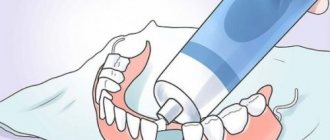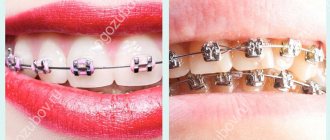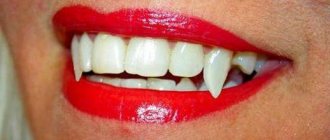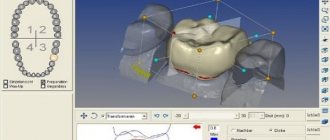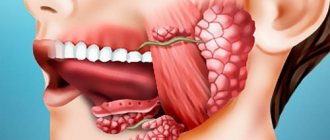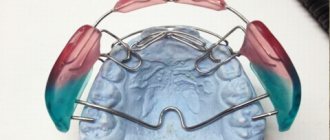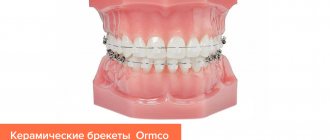1785
To fix the prosthesis in the mouth, preventing it from moving, clasps are used in orthopedics.
With their help, pressure is redistributed during the act of chewing. At the same time, they cover the dental unit only 2/3 of its circumference, creating support and ensuring retention of the prosthesis.
Classification of clasps
Clasps are classified as follows:
According to the material used they are:
- metal (these include: chromium-nickel, gold-platinum and cobalt chromium);
- plastic;
- made in a combination of metal and plastic.
According to the manufacturing method, clasps are divided into:
- stamped clasps;
- bent-cast clasps.
By functions performed:
- retaining clasps;
- support-retaining clasps.
The shapes of clasps are:
- ribbon type;
- round type;
- semicircular appearance.
At the location of contact:
- periodontal clasps;
- dental clasps;
- gum clasps.
Based on the degree of coverage of teeth, the following are distinguished:
- one-shoulder;
- changeover;
- double;
- double shoulders;
- T-shaped;
- ring-shaped;
- multi-link.
According to the connection with the base of the prosthesis, clasps are:
- stable or rigid;
- semi-labile or springy;
- labile or articular.
Design features
Retaining type clasps consist of the following elements:
- The shoulder performs the function of holding the clasp on the tooth surface. This element ensures the spring properties of the structure and the transfer of pressure to the support unit. The shoulder should not have sharp protrusions to avoid injury to the gum tissue and cheek.
- The body is an element of the product placed on the surface of the tooth and connecting the shoulder and the process of the clasp.
- The process performs the function of fixing the fastening in the prosthetic structure. Placed under the plastic components of the hook.
In support-retaining clasps, in addition to the shoulder and body, there is an occlusal pad that prevents tooth displacement when pressure occurs on it, and an anchor part - an element connecting the clasp to the metal base.
Clasp design
Clasps consist of:
- Shoulder.
- Bodies.
- Scion.
The shoulder is a special part of the clasp, which is designed to cover the crown of the tooth. This element is located between the gum and the equator. The shoulder should fit tightly to the entire surface of the tooth along its entire length. In addition, it must completely replicate the tooth configuration itself and be strong enough.
Additionally, individual elements are distinguished in the clasp arm itself
- Support part. It is only 2/3 of the length of the shoulder and is always located higher than the boundary line. Its functions include: the ability to prevent the prosthesis from moving to the side and maintaining a given rigidity. Due to its rigidity, the denture does not spring back or experience deformation under pressure from chewing.
- Retaining part. It is only 1/3 of the length of the shoulder and is located lower than the boundary line. The retaining part ensures fixation of the prosthesis.
The extension is intended for a rigid connection of the clasp itself with the base of the prosthesis. It is installed under the artificial teeth themselves.
The body of the clasp connects two other elements: the shoulder and the process. It is a spring part that must be placed on the contact surface of the teeth (that is, on the crown itself). Usually the body is located below or above the equator.
Support-retaining clasps consist of:
- shoulder;
- the body itself;
- occlusal overlay (it is located in the intertubercular groove, which is located longitudinally; if the tubercles are very pronounced, then the overlay allows you to keep the tooth from moving when an angular force acts on it);
- anchor part (with its help the clasp is connected to the metal frame).
Clasp dentures
A clasp denture with clasps is a product with a metal frame. An acrylic or nylon base and artificial teeth are fixed to it. This type of prosthetics in the absence of several teeth is considered one of the most popular.
The advantages of a clasp denture with clasps include:
- compared to plate ones - small in size;
- no negative impact on taste perception, diction and tongue movement;
- long service life – 5 years;
- slow gum atrophy.
The clasp denture on the lower jaw does not fall out when talking or chewing food. This became possible thanks to the presence of a splinting structure with hooks, which further strengthen the teeth with increased mobility.
One of the disadvantages is the low aesthetics, because the hooks are visible, especially if they are on the front teeth. Under their influence, supporting teeth may begin to collapse. Since the hooks rub the mucous membrane, it takes a long time to get used to the clasp denture on the lower jaw.
Clasps and boundary line
The choice of the clasp to be installed is influenced by the position of the equator or boundary line. There are five types of boundary lines:
- The first type: when the boundary line starts from the very contact point on the side where the defect in a row of teeth is located and further along the surface it descends to the middle of the approximal surface of the tooth next door. With this arrangement, the Roach clasp and the Bonigrad clasp are always used.
- The second type: when the equator passes in the middle of the approximal surface and smoothly rises to the contact point of the adjacent tooth along the vestibular surface. With this arrangement of the boundary line, an Acker clasp is usually used, which works as a support-holding mechanism.
- Third type: when the equator on the supporting tooth is located diagonally. In this case, the boundary line runs in the area of the defect in a row of teeth near the chewing surface. It tangentially crosses the vestibular surface of the supporting tooth itself and ultimately ends on the neck of the tooth on the completely opposite side. Usually in this case Ney clasps are used.
- The fourth type: when the equator is located very high due to very high tooth abrasion. It practically goes at the level of the chewing surface itself. Usually, with this position of the boundary line, the teeth simply need to be covered with crowns. Only thanks to the latter can their anatomical shape be restored.
- The fifth type, when the boundary line is located below. Typically, this feature is observed in teeth that have the appearance of a truncated cone. The equator itself passes along the level of the tooth neck. Usually in such cases only support clasps are used.
conclusions
Despite the fact that Ney clasps were developed in the middle of the last century, their use is still relevant today.
The simplicity of the design ensures high practicality, wear resistance, and, importantly, after installation a high degree of aesthetic value is noted.
In addition, to minimize the occurrence of breakage, areas located closer to the base are made thicker and more durable, and distant sections tend to gradually thin out, taking on the shape of the oral cavity.
If you find an error, please select a piece of text and press Ctrl+Enter.
Tags: removable dentures
Did you like the article? stay tuned
Previous article
Aquasplint is an innovative method of treating and diagnosing TMJ abnormalities
Next article
How to effectively and quickly remove plaque?
Types of clasps
Let us next consider several common types of clasps.
Retention clasp
It is a subsequent invention after the conventional wire clasp. The wire structure was a hook, which is installed on the tooth itself near its neck. Later this clasp was modernized and at the moment it has several varieties. Retaining types of clasps include: alveolar and dentoalveolar.
A classic support-retaining clasp consists of two arms, a process and an occlusion pad. One of the best representatives of this type of clasp is the Ney system. Since the clasp fracture mainly occurs near the base of the prosthesis, the upper shoulder part and the body itself were created thick and rigid. Since the upper part became rigid, it began to be positioned higher than the center line. As a result, such a placement of the clasp began to provide a supporting installation and at the same time prevent the lateral displacement of the prosthesis itself. In addition, the lowest thin part is located slightly lower than the boundary line. As a result, it serves as a supporting element and does not allow lateral displacement of the prosthesis. The lower part securely fixes the prosthesis itself. The upper part is located higher than the boundary line.
Ney system
In addition, by design, the rigid and thick shoulder becomes thin towards the bottom, as a result of which such clasps have the shape of a horn.
The Ney system mentioned above has five different types of clasps:
- single-arm;
- Roach's forked;
- Acker's double shoulder;
- ring one-arm.
- combined.
Ney's system was introduced in the last century. It is highly valued for the fact that when fixing clasps, it is not necessary to wear crowns. Moreover, this installation is suitable for absolutely any dental condition. Prosthetics with the Ney system is one of the gentle procedures. It completely eliminates injury to the enamel and safely distributes the load.
Ney systems are distinguished by their durability, even in case of everyday wear. In addition, they are valued for their excellent elasticity and enviable practicality. While wearing it, patients note that they do not experience discomfort.
Roach clasps
They are a core structure. Roach's Klemmer has long arms, which makes it very springy. Due to this feature, the horizontal load on the teeth is reduced.
The described rod elements can be used on both one and two sides. They are always made of chromium and nickel.
Roach clasps are valued for:
- The aesthetics of a smile.
- The best option for short teeth.
- Possibility of making good retention in various places of support.
However, Roach clasps cannot be used for anatomical disorders of the dentition. Especially when the upper gum is clearly visible when smiling.
Acker's clasp
It is the most effective and practically accessible. It has a very simple design and does not allow clasp dentures to move. It is very often used during prosthetics if one or more positions are missing in the dentition. The only condition in this case: the supports must be preserved. Typically, Acker clasps are used on molars. Since they have a fairly strong and rigid composition. Among the disadvantages, one can highlight the not very good elasticity of the material.
Bonneville clasps
They are two special occlusal pads that are located in the fissures of premolars and molars. Such clasps have two shoulders (on each side), as well as two occlusal pads. Bonvin devices are often used to stabilize and fixate dentures on unilateral defects. And also in order to preserve the teeth on the opposite side.
Jackson clasp
It is a reversible design. This is a special support-retaining clasp, which is a loop. This loop extends across the interdental spaces and is located on the vestibular surface lower than the equator. This clasp is supported by loops that lie in the interdental spaces. And the fixing parts themselves are located just below the equator. The Jackson clasp can be made cast or it can be wire.
Ney's clasp system
This is one of the best artificial structures of its kind. The Ney system clasp has an important advantage - there is no need to use crowns. Therefore, a healthy tooth is not injured during grinding; when chewing food, the load is distributed to the chewing teeth. The denture is fixed with several fasteners, each of which is located in a specific place to hold the product in one position.
The advantages of this product are:
- reliability;
- elasticity;
- practicality;
- long operating period.
Requirements for the location of clasps
To successfully install clasps you must:
- So that the tooth itself is very stable. If the doctor identifies pathological mobility, he will attempt to block it in order to ultimately obtain a stable system. If the patient’s teeth have inflammatory processes at the apex of the tooth, then before installing the support they must be sealed.
- So that the teeth have the correct anatomical shape. Teeth with a rather low crown along the cone, with an incorrect ratio of the length of the root and the clinical crown itself, as well as teeth with an exposed neck, are not suitable for installing clasps. The listed symptoms are relative. They can be eliminated and you can safely proceed to installing clasps.
- So that the supporting tooth has the correct relationship with the antagonist. Relationships can be very close. In this case, even a very small pad, which is placed in the fissure itself, greatly disrupts the bite. In such a situation, a completely different tooth is chosen to install the supporting element. Another solution is to install a protective crown on the initially selected abutment tooth.
Background of creation
In 1949 of the last century, American researchers (dentists, mathematicians and metallurgists) developed and implemented the Ney system. The principle of the new system was the use of clasps made by casting, which load the tooth only in the axial direction.
This technique has become a breakthrough in prosthetics, since when installing clasps there is no need to wear crowns, and its use is possible for any condition of the teeth.
In addition, the newest procedure turned out to be safe for the patient, since it does not cause traumatic damage to the surface enamel.
How clasps are made
The hook with which the denture is fixed can be made only using existing theoretical knowledge and concepts of a particular specialty. To make the right clasp, you need to know what types of prostheses will be attached with its help. The manufacturing technology of any clasps has the same sequence of actions. Here it is very important only to correctly follow the stages of the entire process and select the right material.
The clasp is always bent with pliers. Any dental technician has them in his arsenal. You can also use round nose pliers and pliers to make a clasp, with which you can make only three bends.
To obtain the clasp arm itself, designed to cover the tooth, one end of the cast wire is bent. The next bend is made using round nose pliers. Using these tools, the body of the clasp is also formed.
Requirements for making a shoulder
- Firstly, the design of the shoulder itself must be made so that it can cover the tooth from the cervical or labial side. It should be located behind the convexity line or otherwise between the gum and the equator.
- The shoulder should not create pressure on the supporting tooth itself, that is, it should be passive.
- Regardless of whether the shoulder is flat or round, it should touch the entire surface of the tooth as much as possible. If the fit is carried out only at one point, this means that increased pressure will be created on the tooth and, over time, the enamel will be erased.
- After the main stages of shaping, the shoulder must be rounded and polished. This is necessary in order to prevent possible injury to the mucous membranes.
- The shoulder must be elastic. The best in this case are wire clasps, not so good - cast ones. However, cast ones more accurately replicate the features of the tooth relief.
Execution of the contact process
In order to fix the created clasp shape, you must use round nose pliers. It is best to bend to the ridge using pliers. Next, the resulting process is crushed on an anvil and notches are made on it so that it is more firmly attached to the base.
Only single-arm clasps are made using the described method. In the case of double-arm execution, the sequence of actions is the same, only two elements are involved in the manufacturing technology.
Possible problems
If the execution technology is violated, undesirable consequences may occur:
— when moving horizontally, the material can put a lot of pressure on the dental units, which makes them excessively mobile;
- the enamel surface may collapse due to minor damage;
— the clasp can cause the formation of pathogenic microflora in the mouth due to food particles accumulating under it.
Important! If something bothers you, do not endure it - contact your dentist.
Side effects from clasps
Denture clasps can cause:
- To the abrasion of the tooth enamel itself due to constant load and micro-movements.
- This leads to a significant deterioration in the hygienic condition of the mouth due to the fact that the clasp is a separate structure and various food debris can accumulate under it. As a result, carious processes begin to develop very quickly. And this destroys the supporting teeth.
- Clasps can cause teeth to become very loose. This happens due to the movements of the prosthesis in a horizontal position. As a result, there is a functional overload of the teeth, which serve as support.
Sources used:
- Kurlyandsky V. Yu. Orthopedic dentistry. — 4th, corrected. - M.: Medicine, 1977.
- Eden SE; Kerr WJS; Brown J. (2002). "A clinical trial of light cure acrylic resin for orthodontic use." Journal of Orthodontics.
- Earls, Stephanie (22 February 2014). "Re-enactor brings George Washington to life." The Washington Times.
- Milward, P.; Katechia, D.; Morgan, M. Z. (November 2013). "Knowledge of removable partial denture wearers on denture hygiene". British Dental Journal.
Useful tips
How to get used to dentures? At the beginning of wearing, many feel pain and scratches appear. You need to make sure that the structure is put on correctly. If this does not help, then you need to visit the dentist.
Pain often appears during chewing, so it is recommended to abstain for a while from solid foods that cause discomfort. Gradually, you need to switch to your usual diet, since chewing load is an important point in getting used to the prosthesis.
How to get used to dentures if you are worried about dry mouth or increased salivation? In this case, it is advised to drink enough water in small sips throughout the day.
The use of special fixing gels and ointments will help to securely secure the structure and prevent the formation of abrasions and wounds. Although the formation of chafing at the initial stage of addiction is considered normal. This process can last 3 months. At this time, the formation of the prosthetic bed occurs. To prevent chafing, you need to:
- clean your denture regularly;
- have the product adjusted by a doctor;
- rinse your mouth after eating.
Often, long-term addiction occurs as a result of an incorrectly selected or ill-fitting product.
To find out how much dentures cost in each specific case, you need to consult a dentist. The reliability of their fastening and the aesthetics of a smile depend on an element such as a clasp. Therefore, you need to choose it responsibly and seriously.
